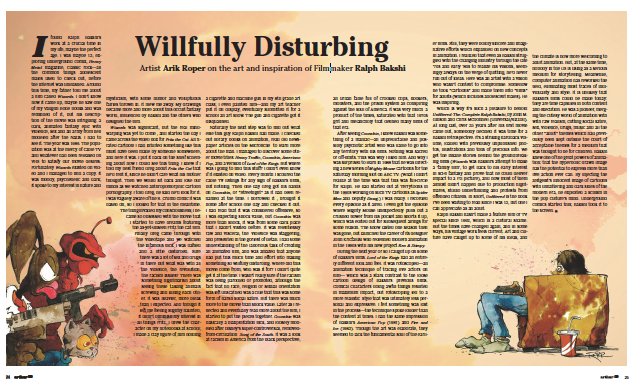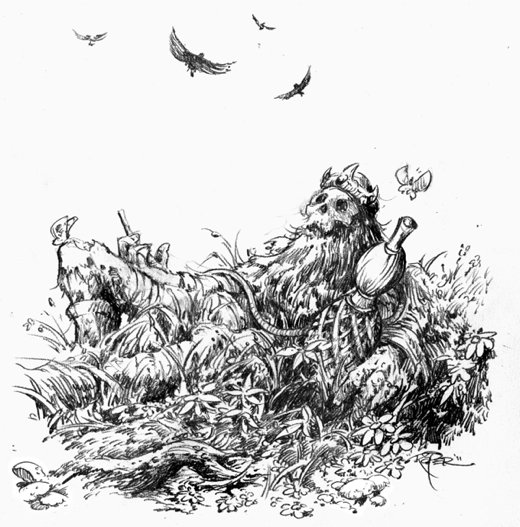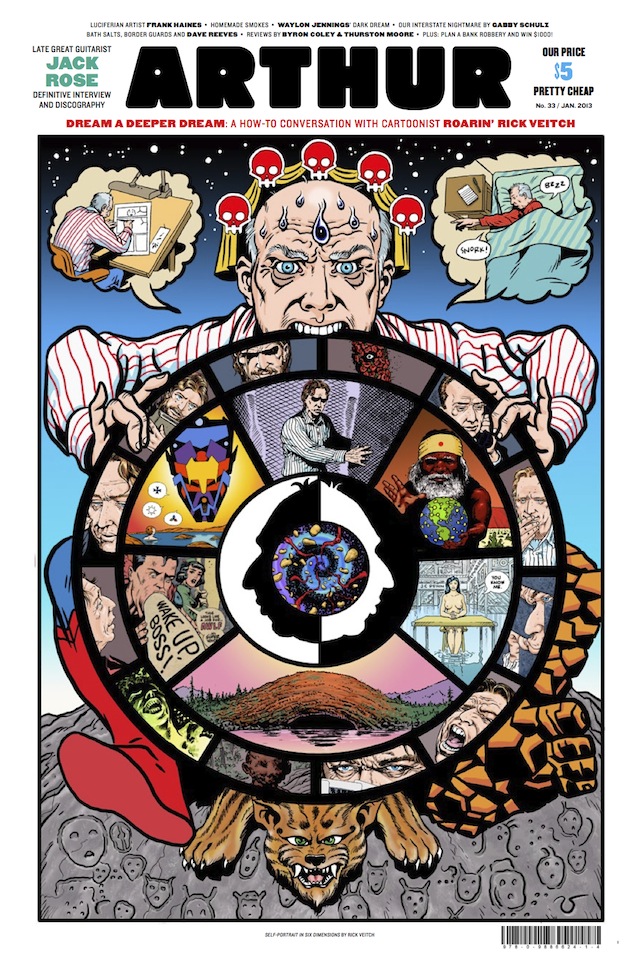Originally published in Arthur No. 29 (May 2008)

WILLFULLY DISTURBING
Artist Arik Roper on the art and inspiration of filmmaker Ralph Bakshi
Art direction by Mark Frohman and Molly Frances
I found Ralph Bakshi’s work at a crucial time in my life, maybe the perfect age. I was maybe 13, exploring underground comix, Heavy Metal magazine, classic rock—all the common things adolescent males used to check out, before the internet was unleashed. Around this time, my father told me about a film called Wizards. I don’t know how it came up, maybe he saw one of my Vaughn Bode books and was reminded of it, but his description of the movie was intriguing: a dark, animated fantasy epic with violence, sex and an army from hell modeled after the Nazis. I had to see it. The year was 1986. The population was at the mercy of cable TV and whatever had been released on VHS to satisfy our movie desires. Fortunately Wizards existed on video and I managed to find a copy. It was moody, psychedelic and dark; it spoke to my interest in nature and mysticism, with some humor and voluptuous fairies thrown in. It blew me away. My drawings became more and more about this occult fantasy world, influenced by Bakshi and the others who designed the film.
Wizards was significant, but the real mindwarping was yet to come , and started the day I came across the video box for Fritz the Cat. An X-rated cartoon! I had intuited something like this must have been made by someone somewhere, and here it was. I put it back on the shelf scheming about how I could see this thing. I knew if I told my best friend Greg about Fritz the Cat that he’d rent it, since he didn’t care what his mother thought. Then we would sit back and lose our minds as we watched anthropomorphic cartoon pornography. I told Greg, he said he’d look for it. I was vaguely aware of the R. Crumb comic it was based on, so I looked for that in the meantime. The thing invaded my consciousness; I became so obsessed with the movie that I started to have dreams featuring the as-yet-unseen Fritz the Cat film. Finally Greg came through with the videotape and we watched the infamous flick. I was baffled and a little disturbed. Sure there was a lot of sex and drugs in there but what was with all the violence, the revolution, the racism issues? There was something nightmarish about seeing these talking animals screwing and killing each other. It was heavier, more bleak than I expected. And though it left me feeling slightly haunted, it didn’t diminish my interest in all things Fritz. I drew the character on my notebooks at school; I made a clay figure of him holding a cigarette and machine gun in my 8th grade art class; I even painted him—and my art teacher put it on display, eventually submitted it for a school an art show. The gun and cigarette got it disqualified.
Naturally the next step was to find out what else this guy Ralph Bakshi had made. I checked out library books on animation, read old newspaper articles on the Microfiche to learn more about the man. I managed to discover some other movie titles: Heavy Traffic, Coonskin, American Pop, and a version of Lord of the Rings. But where was I going to find this stuff? I didn’t even know if it existed on video. Every month I scoured the cable TV listings for any sign of Bakshi’s films, but nothing. Then one day Greg got his hands on Coonskin, or “Streetfight” as it had been renamed at the time. I borrowed it , brought it home after school one day and checked it out. I had read that it was considered offensive, so I was expecting shock value, but Coonskin was more than shock, it was from some dark place that I hadn’t visited before. It was relentlessly raw and visceral, the violence was staggering, and presented in the goriest of detail. I had some understanding of the laborious task of creating an animated film, and was amazed that anyone had put this much time and effort into making something so willfully disturbing. Where did this movie come from, who was it for? I didn’t quite get it at the time. I wasn’t really sure if the racism was being parodied or promoted, although the fact that no race, religion or sexual orientation was left unscathed was a clue that this was some form of harsh social satire. But there was much more to the movie than shock value. Later as I reflected and eventually read more about the film, I started to put the pieces together. Coonskin was basically a blaxploitation flick, and loosely modeled after Disney’s super-controversial, removed-from-circulation Song of the South. It was a look at racism in America from the black perspective, an urban fable full of crooked cops, hookers, mobsters, and the prison system all conspiring against the soul of America. It was very much a product of the times, saturated with that 1970s grit and melancholy that defined many films of that era.
After seeing Coonskin, I knew Bakshi was something of a maniac—an unpredictable and possibly psychotic artist who was liable to go into any territory with his films. Nothing was sacred or off-limits. This was why I liked him. And why I was surprised to learn in 1988 that he was directing a new series of Mighty Mouse cartoons for the Saturday morning slot on ABC TV. (What I didn’t realize at the time was that this was full-circle for Ralph. He had started out at Terrytoons in the 1960s working on such TV cartoons as Spiderman and Deputy Dawg.) I was ready. I recorded every episode as it aired. I even got the episode where Mighty Mouse unexpectedly pulls out a crushed flower from his pocket and snorts it up, which was edited out for subsequent airings for some reason. The show lasted one season then was gone, but launched the career of its designer John Kricfalusi who redefined modern animation in the 1990s with his new project Ren & Stimpy.
During the next year or so I caught up on some of Bakshi’s films. Lord of the Rings had an entirely different look and feel. It was rotoscoped—an animation technique of tracing live actors on film— which was a stark contrast to the loose cartoon design of Bakshi’s previous films. Comical characters doing awful things resulted in maximum impact, but rotoscoping led to a more realistic style that was ultimately less personal and expressive. I felt something was lost in the process—the technique spoke louder than the content at times. I had the same impression of Bakshi’s American Pop (1981) and Fire and Ice (1983). Though the art was elaborate, they seemed to lack the fundamental soul of the earlier films. Still, they were boldly sincere and imaginative efforts which expanded on new concepts in animation. I realized that even as Bakshi struggled with the changing industry through the late ’70s and early ’80s to realize his visions, seemingly always on the verge of quitting, he’d never run out of ideas. Here was an artist with a vision who wasn’t content to compromise. Somehow he took “cartoons” and made them into “films” for adults (which includes adolescent males). He was inspiring.
Which is why it’s such a pleasure to behold Unfiltered: The: Complete Ralph Bakshi, by John M. Gibson and Chris McDonnell (Universal/Rizzoli). At long last, over 35 years after his first movie came out, somebody decided it was time for a Bakshi retrospective. It’s a striking hardback volume, loaded with previously unpublished photos, illustrations and tons of precious info. We get the insane stories behind the groundbreaking films (Wizards was Bakshi’s attempt to make a “family film,” to get back to his early interest in sci-fi fantasy and prove that he could deliver impact to a PG picture), and how most of them almost didn’t happen due to production nightmares, studio underfunding and protests from offended citizens. In short, Unfiltered is the book I’ve been waiting to read since I was 13, but one I can appreciate as an adult.
Ralph Bakshi hasn’t made a feature film or TV special since 1992, which is a cultural shame. But the times have changed again, and in some ways, his vintage work feels current. Art and culture have caught up to some of his ideas, and the climate is now more welcoming to adult animation. But, at the same time, nobody in the US is using as a serious medium for storytelling. Meanwhile, computer animation has reworked the field, eliminating most traces of individuality and style. It is unlikely that Bakshi’s films could be made today: they are time capsules in both content and execution. He was a pioneer, merging the cutesy world of animation with with raw realism, cutting social satire, sex, violence, drugs, music and all the other “adult” themes which had previously been kept outside the court of acceptable themes for a medium that was thought to be for children. Bakshi knew one of the great powers of animation: that the hyperbolic drawn image has the potential to express more than live action ever can. By injecting the zeitgeist’s innocent image of cartoons with unflattering and dark sides of the modern era, he exploited a schism in the pop culture’s mind. Underground comics started this; Bakshi took it to the screen.








